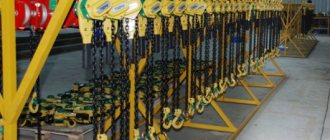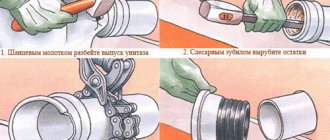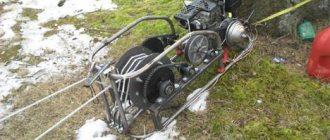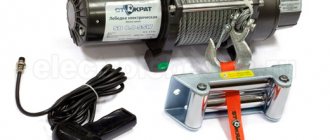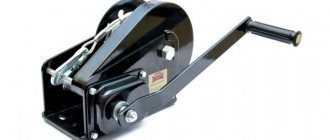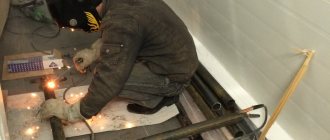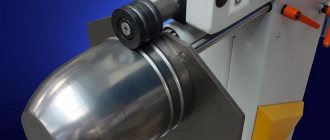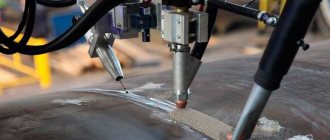Types and structure of the main components of hoists
A hoist is a lifting device that is fixed to beams or special mobile trolleys moving along a crane beam. Due to the hook block suspension of the electric hoist, lifting, lowering and horizontal transportation of goods is ensured.
By type of drive, the equipment is divided into:
- manual,
- electric (telphers).
In manual hoists, the traction mechanism is a gauge chain (welded or plate), which goes around chain blocks or sprockets. There is a wide specification of models of manual lifting devices. The chain mechanism of the hoist can be gear or ratchet lever. The presence of a chain will allow the device to work without a drum, making it small in size and weight. The device is activated by the muscular force of the operator. The equipment can be used as a stand-alone lifting mechanism or in conjunction with a beam crane.
Manual hoists are available in the following types:
- lever,
- mobile,
- stationary.
To work with stationary equipment, an operator must be present directly near the load. The presence of a rotating casing allows you not only to raise and lower the load, but also to unfold it for more convenient work. The lifting capacity of manual devices is 1, 3, 5, 8 tons. The electric hoist moves loads using a mobile structure located in a small-sized housing and additionally equipped with a hook and cable. There is also a gearbox, a drum for winding up the lifting rope, a coupling, a mobile trolley, wheels, a hook suspension, and a cargo rope fastening. This type of lifting device contains an electric motor. The operator controls it using a push-button station. Electric hoists can be mobile - they are fixed on a mono- or double-rail track (beam crane). A double-rail fastening is considered the most reliable, because it prevents the risk of swinging and overturning the load. The load capacity of mobile hoists is 0.25-16 tons, the lifting speed of the load is 0.05-0.15 m/s, the lifting height is up to 30 m. Stationary hoists are appropriate when working with loads weighing more than 50 tons. The marking rules for this equipment provide detailed reflection of all technical characteristics of the equipment.
How to make talcum powder with your own hands
A winch is an indispensable device both in the household and in the garage. Lift a roll of roofing felt onto the roof, throw a couple of bags of cement into the second floor window of a private house under construction, pull the engine out of the hood, and drag the broken car itself into the garage... This is an incomplete list of tasks that can easily be done alone with its help.
Drum-type devices for lifting or moving heavy objects differ in the way they transmit torque. From our school physics course we know how the shoulder works. Losing in speed or distance, we gain in strength. The phrase of Archimedes: “Give me a fulcrum, and I will turn the Earth upside down” precisely describes the principle of operation of the winch.
A manual winch, with the help of an attached shoulder, increases human strength so much that one operator can move cars or lift weights of several hundred kilograms. Although the principle of operation is the same (from a mechanical point of view), these devices have different methods of execution.
Manual drum winch - varieties
A hand winch with a drum is a classic of the genre. In addition to the common element - the pulley on which the cable is wound, the devices have different types of drive.
Single speed gear drive
A large, main gear is firmly attached to the drum. The entire load falls on it, and on the fastening. Therefore, the reliability of the elements must be at the proper level. In mesh with the main one, there is a small driving gear.
The ratio of the number of teeth is the value of the gear ratio. In other words, gain. The drive gear is integral with the drive shaft. Since we are talking about a hand tool, a handle is attached to the shaft for rotation.
The length of the lever also affects the degree of reinforcement. The larger the handle arm, the less effort you need to apply.
With the help of such devices, you can single-handedly lift several centners of cargo or move a car weighing 2-3 tons. At the same time, the rotation speed of the drum is quite high.
Multi-speed gear drive
The design consists of two or more pairs of gears, each of which has a gain of tens of times. With sequential engagement, these coefficients add up, multiplying the force.
The other side of the coin is a proportional reduction in speed. Having such a winch, you can slowly vertically lift loads of more than a ton, but if you have to work with two bags of cement, the lifting time will stretch for tens of minutes.
Therefore, manufacturers have provided the opportunity to use each pair of gears separately. By fixing the handle on a straight pair, we get medium force at high speed. By transferring it to the second pair, we lose speed, but double our strength.
A mandatory element of all manual winches is a stopper, or “pawl”
It works on the principle of a ratchet mechanism. After the force on the handle stops, the teeth of the sprocket rest against the stopper, preventing the cable from unwinding under the weight of the load. This improves safety, but the mechanism has a disadvantage.
It works perfectly when going up, but is completely useless when going down. During reverse rotation, the pawl is simply thrown to the side, releasing the ratchet.
Worm drive
To increase the force, a worm mechanism is used. The principle of calculating the transmission pair, compared to flat gears, is somewhat different, but the technique is the same. A small-diameter helical gear rotates the main gear mounted on the drum.
The advantage of the design is the high gain. Another plus is that the design is self-locking. That is, if you do not apply force to the handle, the machine will stop. This increases safety and comfort.
The handle can be rotated in any direction, lifting and lowering the load - without fear of it falling off.
A serious design flaw is the high friction in the worm pair. The mechanism needs constant lubrication, otherwise wear will be simply catastrophic. When working “dry,” the pair may simply jam.
Considering the mechanics of the process, there are restrictions on the weight with which you can work. But the tool turns out to be compact and is often used in the home.
Planetary reductor
With outstanding compactness (the gear mechanism is actually located inside the drum), the number of gear pairs can reach up to ten. The gain with this design can reach hundreds of times. The only drawback is the high cost of the product, so it is rarely used in everyday life.
Manual
Manually driven hoists are available in worm, lever and gear models.
Manual gear hoists
They can be located at any height, ensuring the movement of the hook up and down under the influence of the physical force of an operator located at some distance - under the action of rotating a special pulley or pulling a closed traction chain. The device must be connected strictly according to the chain hoist installation diagram. To lift a load, the operator only needs to secure the upper locking hook into the traction ring. The device of the manual hoist allows it to be attached to a carriage on rollers on an I-beam. The operator can control the equipment from ground level using a special rod up to a height of 12 m, while models with worm and lever gears are controlled from a certain height.
Manual lever hoists
The advantage of lever hoists is the absence of a drive chain, which simplifies their operation. Using this equipment, a person lifts and lowers a load using a lever handle. The operator must be on top to ensure that the hoist is maintained in a raised state and it is convenient to lower the load. The design of lever hoists allows them to be used at temperatures not lower than -40°C, the weight of the products being understood is no more than 3 tons, the lifting height is no more than 9 meters. Violation of these requirements will lead to premature wear of cables, bearings, bolt fastenings and failure of the mechanism.
Manual worm hoists
The operation of the device is ensured by a worm gearbox. Its presence allows you to obtain the greatest traction, ensures reliable fixation of the lifted products, but at the same time limits the lifting speed, and also significantly makes the lifting equipment itself heavier. The following types of worm gear devices exist:
- Stationary. They are used for installation and repair, and can be included in the design of a single-girder crane mechanism. The lifting height can reach 12 m (in some cases - up to 24 m), load capacity - from 1 to 8 tons. The advantages of this type of hydraulic lifting machine include a relatively low price;
- Mobile hand worm gear. The design of the chain hoist allows you to lift loads weighing up to 10 tons to a height of up to 24 m;
- In explosion-proof design. Used in facilities where there is a risk of explosions. In terms of load capacity and lifting height, they do not differ from the previous two types, but have much more weight.
Tips and tricks when choosing chain hoists
Lifting equipment is purchased with long-term use in mind. To avoid mistakes, it is advisable to pay attention to a number of points before purchasing.
- Load capacity. You should not limit yourself to the maximum weight of current cargo. It is quite possible that tomorrow more powerful lifting mechanisms may be required. Therefore, it is better to purchase a model with a carrying capacity reserve of 20-30%.
- Lifting height. As a rule, manual hoists are produced for lifting loads to a height of 1.5-9 m. There are models that lift the hook to 18 meters or more. It is worth choosing the model that will most accurately match the parameters of the working site in terms of lifting height.
- Presence of anti-corrosion coating on metal surfaces. The body of the hoist side, as well as the chain, must have a protective coating of powder paint or galvanization. This will allow you to operate the equipment outdoors.
- Safety certificates. Their presence will confirm the safety of the device for personnel.
In addition, the availability of service centers is important. Like any mechanism, a manual hoist requires regular maintenance and sometimes repair. A nearby service station will speed up service and reduce losses from equipment downtime.
Electric (telphers)
The use of an electric hoist significantly speeds up and simplifies the performance of lifting operations with loads, and helps to increase labor productivity. Any hoist model can be used as an individual lifting mechanism or as part of an overhead, console or gantry crane. The design of the electric hoist allows it to be used for lifting, lowering and moving products within the permissible load capacity and the length of the rail track on which the equipment is mounted. Depending on the presence/absence of a movement mechanism, hoists are divided into stationary and mobile. The general design of the equipment provides for the presence of switches for the upper and lower positions of the hook suspension, a brake, and an emergency switch for the upper position of the suspension. The equipment is designed for use in enclosed areas of workshops and warehouses in the temperature range from -20 to +20 °C. Some device models can be used outdoors at temperatures from -40 to +40 °C. In the latter case, additional protection of the equipment from possible atmospheric influences must be provided using a metal casing. To use equipment in aggressive environments, fireproof and explosion-proof models must be used.
Electric hoist series TE (Russia)
This is a common class of highly reliable lifting equipment, the design of which involves the use of a combination of movable and fixed blocks and pulleys. The lifts move horizontally along the I-beam, ensuring the movement of loads in the vertical plane of loads due to the unwinding and rewinding of a chain or cable. Russian electric hoists of the TE series are highly practical and efficient and are suitable for working with loads of various weights. The equipment has been produced in Russia for 70 years, and every year the designs of the devices are only further improved and the model range is expanded. The TE series hoist is used in a variety of areas - from small auto repair shops to large industrial facilities. The equipment is popular in enterprises involved in transportation and construction sites. The mechanisms are capable of operating in a temperature range from -40°C to +40°C in enclosed spaces and under cover. Explosive models are available.
Electric hoists CD series (China)
Chinese CD series electric hoists combine high performance, power and affordability. With their help, you can move loads in a horizontal direction - as a rule, along a monorail track installed under the ceiling of the room. The equipment can be used at temperatures from -25°C to +40°C with a humidity not exceeding 85%. The devices are designed to work indoors or under a canopy. It is prohibited to use them to move explosive and toxic substances, molten metals, etc.
Electric hoists T10 series (Bulgaria)
Bulgarian hoists of the T10 series are very popular in Russia and the CIS countries. The equipment combines reliability, durability, has a simple design and a relatively low price. In the standard version, the mobile electric hoist of the T10 series has a built-in travel brake and thermal protection of the lifting motor. It is possible to adjust the width of the trolley, which allows you to install the hoist on a monorail track of different widths. The lifting capacity of the equipment is from 0.5 t to 12.5 t. At the request of the client, Bulgarian hoists can be equipped with a micro lifting speed or micro moving speed, a load limiter, etc. The hoist is designed for use both indoors and outdoors.
Mini electric hoists
Equipment of this class is designed to work with loads weighing from 125 kg to 1 ton. Movement is carried out along a suspended monorail track with low intensity. The advantages of this equipment include compact size, light weight, the ability to use it from a 200V network and affordable cost. The devices are presented in stationary and mobile models. Lifting height is up to 12 m. The mini hoist can be used as part of an overhead, jib or overhead crane.
Lever hoist – advantageous physics of load capacity
This type of hoist is necessary for working with small loads, the weight of which is no more than 5 tons, and it can be raised to a height equal to the height of a person. It all depends on the design solution. Raising, lowering and moving is carried out using a lever built into the body. The hoist is controlled by an operator located near the device. Such models are good for tensioning cables and lifting loads. Since they are not suitable for a large volume of work, utility services find use for them.
They are necessary when you need to tension cables or install pipes at the bottom of trenches, as well as for installing hatches. With their help, foresters pull out stumps, and industrialists place heavy equipment in workshops. Often their purpose is to lift a load in order to work with it, which is how a jack works. This can be various repair work, for example, in car repair shops. To make working with lever hoists easier, they are additionally equipped with special trolleys.
Manual hoist lifting mechanism
A manual hoist (with a mechanical drive principle) operates solely under the influence of the operator’s muscular force and is associated with a gear or worm gear. The hoist moves loads vertically; a special trolley is used for horizontal movement. The operating principle and design of a manual hoist are as follows: the operator stands below and moves the chain with his hands, raising or lowering the load. The device contains a drive arm and a hanging hook that allows for 360° rotation.
How to make a hoist with your own hands - Metalworker's Guide
Making a hand winch: instructions and video
The winch is one of the oldest devices that facilitates the movement of heavy objects, invented by man much earlier than he knew the laws of physics.
The principle of operation of the winch is based on the rule of leverage: by applying minor forces to the handle, you can move and lift quite heavy objects. Winches and hoists are widely used on the farm for lifting building materials, dragging loads, and even for plowing land.
Advantages of manual hoists
Manual hoists are suitable for use in small businesses and facilities where there is no power supply. The main advantages of manual hoists include:
- versatility,
- ease of installation,
- compactness,
- mobility,
- operational simplicity,
- Ease of use,
- high reliability,
- long period of trouble-free operation,
- simple maintenance,
- affordable price,
- Possibility of use both in open space and in cramped conditions.
Electric hoist operating diagram
An electric hoist is a small-sized winch, the elements of which (electric motor, gearbox, rope drum, brake, cabinet with starting equipment, etc.) are mounted in one housing or fixed to this housing. The mechanism also includes a hook suspension and a chassis for moving goods along the monorail track. The operating principle of an electric hoist is to rotate the drum using a motor and gearbox, during which the cable is wound. Operating the hoist does not require significant physical effort from the operator and is done remotely using a pendant and radio control. According to the method of movement, electric hoists are divided into 2 groups:
- Stationary. They are fixed on a console or beam and move loads only up or down;
- Mobile. They are attached to a mobile mechanism, a “cat”, and ensure the movement of loads up and down and movement in a horizontal plane. The equipment is designed for use in large workshops, hangars, and anywhere operations with heavy cargo are carried out.
Hoist operating conditions
It is prohibited to operate the hoist in an explosive environment; it is not allowed to be used for lifting and moving people, as well as toxic materials and hot metals.
Before starting to operate the hoist, the operator who will perform work using this device must be certified: undergo training in the use of this mechanism and pass exams for the right to operate it.
Worm hoists must comply with all explosion safety standards and requirements and undergo regular inspection by relevant specialists who supervise lifting mechanisms and record the results in the inspection log assigned to a specific workshop.
These lifting devices can be used in various weather and climatic conditions, as they have fairly good resistance to negative atmospheric factors.
Advantages of electric models
The undeniable advantages of electric hoists include:
- High power and performance. The presence of an electric drive eliminates the need for the operator to expend significant muscle power. The speed of product movement increases several times - up to 12 m/s, while when working with manual models, a movement speed of no more than 3 m/s is ensured;
- Safe work. The employee controls the device remotely - using a remote control panel while being at a safe distance from the objects being moved;
- Economical. The electric drive provides high traction force and significantly reduces the time for lifting and moving loads. The use of a hoist allows you to reduce the number of employees providing maintenance to lifting equipment. Such savings more than pay for the costs of energy supply;
- Significant load capacity – up to 50 tons;
- High maintainability;
- Reliability and durability;
- Versatility. Electric hoists are designed to operate autonomously, and can also be part of a large lifting structure. The equipment is installed on jib, bridge, and console cranes.
Chain selection
At the moment, manufacturers offer to choose the best option for this type of equipment for working in a warehouse, where the movement of cargo is carried out through the use of endless (closed) chains of various types.
The choice of chain option is based on the type of use of warehouse equipment, the mass of goods that will be moved due to the operation of such a device.
Among the offers are the following chains:
- round-grained high-strength calibrated cargo type, corresponding to TU 14-178-255-93, having a chain size of 1-B-6*19 mm, designed to work with weights up to 1 ton;
- round-grained high-strength calibrated cargo type, corresponding to TU 14-178-255-93, having a chain size of 1-B-6*27 mm, designed to work with weights up to 5 tons;
- round-grained normal strength calibrated traction, corresponding to TU 14-178-255-93, having a chain size of 1-N-6*19 mm, designed to work with weights from 1 ton to 8 tons;
Models of chain mobile hoists are ready to lift loads to a height of 3 to 12 meters, the weight of which, depending on the type of hoist, can reach 8 tons.
The weight of the hoists themselves also depends on their potential lifting capacity. The weight of these products themselves can vary from 30 kilograms in the minimum configuration and up to 500 kilograms in the maximum configuration. Small-sized models are convenient for private use. They are also attractive for private construction, for example, the construction of a country house. Can be used in small businesses. Compact models are attractive to transport and can be easily transported from one job site to another.
Currently, the market offers various types of such products with different functionality, manufactured by manufacturers in China, Russia, and Eastern and Western Europe. Proposals made in China belong to the most attractive price category. In case of using a product with not the highest level of load, it is these options that can become a profitable purchase.
For long-term use, it is recommended to choose products manufactured in other countries. Specialists from companies offering hoists of this type for sale are always ready to provide the most detailed advice.
Areas of application for different types of hoists
Manual and electric hoists are the most common lifting machines in the world. Equipment of this class has a wide range of applications in various sectors of life - construction, manufacturing, industry, private households. Wherever operations with cargo are required, these units are used. The variety of lifting characteristics and the possibility of installing hoists on a rail movement system allows the installation of trolleys on production lines, workshops and warehouses where high accuracy and stability of lifting operations are required. However, the introduction of high-tech motors into the design of hoists has tightened the technical requirements for their installation and operating mode. Strict compliance with all safety rules is mandatory.

